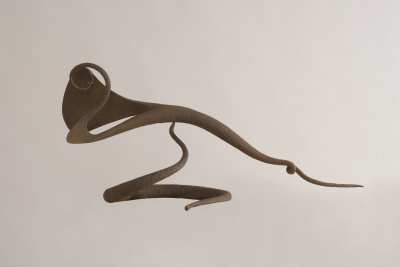Lesson Plan: Influences I Extension: Kinetic Sculpture
Inspiration: Here is a quote from Kington's oral history interview of 2001 (https://www.aaa.si.edu/collections/oralhistories/transcripts/kingto01.htm) (Smithsonian Archives) on the weathervane series and the Icarus series of kinetic sculpture:
"The weathervanes were about implied motion and real motion. My intention was that as the pieces moved, space opened and closed, and it never appeared the same. Or when the viewer found himself in a different relationship to the piece from one time to the next, it almost appeared like a different piece; the gesture would change. It was about lyricism.
"When I say implied motion, the forged line implied movement - and changed to the viewer when wind moved the piece. It was beginning to develop themes, symbols. The large disk, in my mind, became the sun; the small disk was the moon. It was talking about planetary, universal relationshhips. The work was about relationships of form and the movement, motion in space, and line and how line looks at different times, from a variety of viewing positions.
(on the fulcrum -point): "I did some other work ...that evolved into the Icarus series, because they did not intend to do anything but play, to move.... the advantage of the fulcrum-point mechanism was not only rotating 360 degrees... but also incuded pitch and yaw. I could make the work dance. So that the weathervanes not only rotated, they would bounce back and forth and rock side to side. And so I started finding that I could orchestrate motion.
"The first one drove me nuts. By the time I got to the end of the series, I could predict within an eighth of an inch the balance point of the piece and where I had to punch the hole. I always thought about it as a weight scale. Put 10 pennies here and 10 pennies here, and things were in balance. Then what attracted me was the fact that it could work with a large form and small form, creating illusions that would look like it shouldn't balance, but it did. And so I had created those tensions in my work. The fact that they just wouldn't come off their fulcrum point unless somebody purposely knocked them off pleased me."
Goal: Students will demonstrate their understanding of artistic influences and kinetic sculpture by creating a kinetic sculpture using the concepts found in the work of Joan Miró, Alexander Calder, George Rickey, and L. Brent Kington, and mechanism of a fulcrum point found in weathervanes and Kington's works.
Concepts:
Pre-test and Post-test questions to answer and keep in mind as you create:
- What is kinetic art?
- What is artistic influence of one artist on another?
- What is artistic influence of a culture upon an artist's work? (early weathervanes on Kington)
- What is the difference between being influenced and copying?
- What elements of an art work, besides materials, can be influenced by another? (e.g., themes, colors, shapes, mood, lines, method of construction, etc,)
- What do you learn by creating an art work in the style of someone else (or in the style of another culture)?
Web sites: Look at these web sites to understand the characteristics of kinetic art and learn about some artists famous for creating it.
- Dr. Michael Delahoyde, Washington State University, page on kinetic art (https://www.wsu.edu/~delahoyd/20th/kinetic.html).
- Early weathervanes on Wikipedia (https://en.wikipedia.org/wiki/Weather_vane)
- George Rickey at Wichita State with images (
- https://webs.wichita.edu/?u=mark2&p=/twolines/)
- Alexander Calder Foundation page on mobiles (https://calder.org/work/category/mobile.html)
- Legacy of Calder article in Sculpture Magazine (https://www.sculpture.org/documents/scmag98/calder/sm-caldr.shtml)

Click image to see enlargement.
Glossary: kinetic art, mobile, weathervane, rotate, pitch, yaw, fulcrum point, lyricism (group activity to look these terms up and discuss them, perhaps demonstrating the actions)
Activity: Students will view the video clip of Brent Kington that shows kinetic sculptures. They should note the size, shape, and balance of the pieces. Look at the Web pages kinetic art. Students discuss the essence of kinetic art, mobiles, stabiles, weathervanes, and in particular, Kington's Icarus series and his weathervanes. After reading his quotes on fulcrum-points and how he made them, draw an example for the class (or show the drawing shown here). (illustrate with DSC0072 from folder 11).
Materials: Gather an assortment of materials available that are suitable for your classroom level. (wood, plastic, paper, wire, metal shapes)


